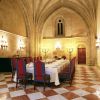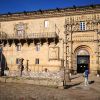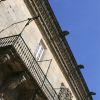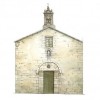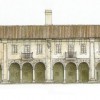- Accede I
- Regístrate I
- carrito
Hostal dos Reis Católicos
S. XVI.
El actual edificio fue mandado construir en 1501 por los Reyes Católicos para atender a los enfermos y peregrinos del divino Xacobe, según se puede leer en la inscripción latina que recorre el friso superior de la portada. Su construcción, no obstante, se decidió ya en 1492 coincidiendo con el descubrimiento de América.
El proyecto de las obras se debe al arquitecto real Enrique Egas. Delante de la fachada podemos ver una fuerte cadena del siglo XVI sostenida por pilares esmeradamente tallados que delimita la propiedad del hospital y que tiene su origen en las disputas de propiedad entre el Ayuntamiento y las autoridades del Hospital. Cuenta con una hermosa portada plateresca obra de los maestros franceses Martín de Blas y Guillén de Colás. En las pilastras de esta portada podemos ver de abajo arriba, las figuras de Adán, Santa Catalina y San Juan Bautista en la izquierda y las de Eva, Santa Lucía y María Magdalena en la derecha. En el friso de la puerta, estructurada a modo de arco triunfal romano aparecen alineadas las figuras de los doce apóstoles. En las pechinas sobre el arco podemos ver los medallones que recogen los bustos de los reyes Isabel y Fernando. Sobre el friso, en el cuerpo superior se abre la ventana del Aposento Real, reservado para hospedar a los monarcas cuando acudieran a Compostela y flanqueada por las imágenes de Cristo, la Virgen, Santiago, San Juan Evangelista, San Pedro y San Pablo. Dos grandes escudos, con las armas de Castilla flanquean así mismo, la portada. Recorriendo todo el frente del edificio vemos los balcones diseñados por fray Tomás Alonso, apoyados en ménsulas muy trabajadas que representan figuras fantasiosas. La cornisa se decora con una minuciosa cadena en la que sobresalen grotescas y obscenas gárgolas.
El espacio interior está estructurado en una planta rectangular con cuatro patios. El más artístico de estos patios es el primero que encontramos entrando a la izquierda, en el que destaca sobre todo, la puerta que conduce a la antigua sala de San Luis. El interior del Hostal alberga una hermosa capilla ojival, declarada Monumento Nacional en 1912. La parte más interesante de esta capilla de planta de cruz latina, situada entre los cuatro patios, es el crucero al que se accede a través de un enrejado de hierro de hermosa factura, obra del cerrajero francés Guillén. La bóveda del crucero, confeccionada en piedra litográfica de Coimbra, es de una bellísima filigrana.








































